We may be compensated if you purchase through links on our website. Our team is committed to delivering honest, objective, and independent reviews on home products and services.
Project details
Skill
Cost
Estimated Time
Few things embody casual summer entertaining like a classic picnic table. In this guide, we’ll walk you through how to build a durable, attractive picnic table using rough-sawn cedar, a material that weathers beautifully to a silvery gray over time. This timeless design, with its X-shaped legs and separate benches, offers comfortable seating for six adults. It combines strength and style, featuring half-lap joints for stability and diagonal bracing to prevent racking. While the angle cuts may appear complex, our simple jig method makes the process straightforward. Let’s dive into the steps to create this backyard beauty that will serve as the centerpiece for your outdoor get-togethers.
Preparing To Build Your Classic Picnic Table
You can complete this project in a weekend, building the table on the first day and the benches on the second day. According to Angi, it will cost between $70 and $500 to build a picnic table, depending on whether you bring in professional help. Start by assembling the wood cuts and tools you’ll need to build your picnic table.
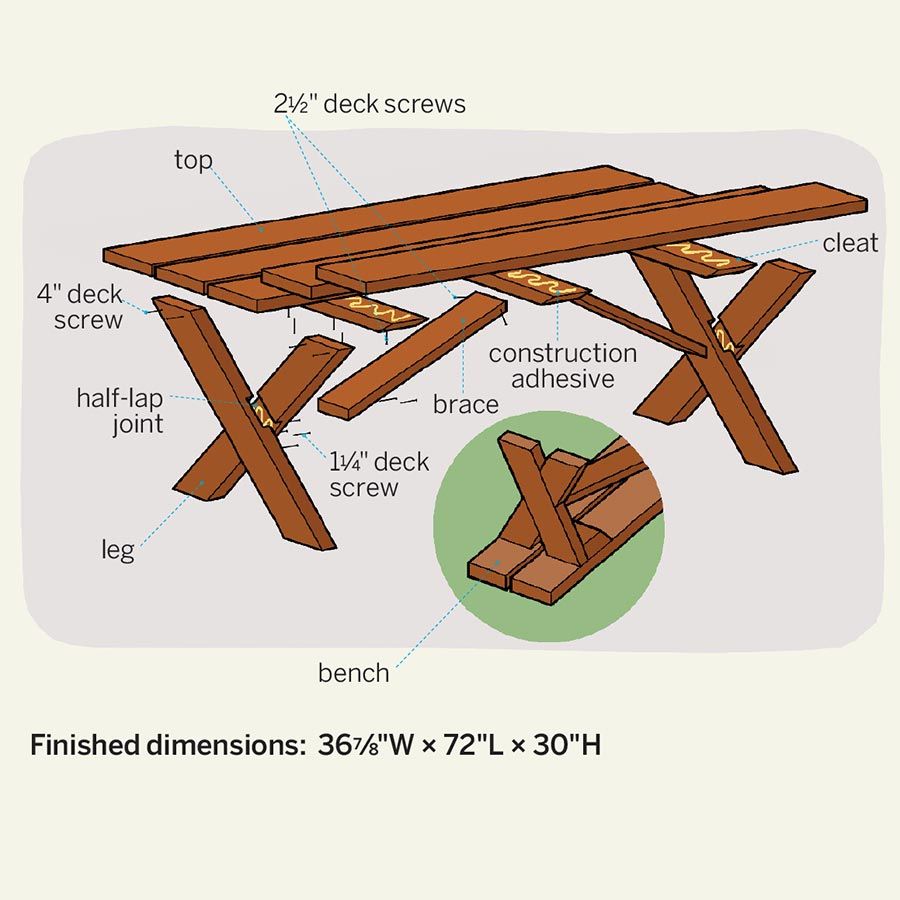
Picnic Table Cut List
For this table, we recommend rough-sawn cedar thanks to its durability and beautiful patina. Here are the wood pieces you’ll need for the table and benches:
- 2×8 tabletop boards: five @ 72 inches
- 2×6 bench-seat boards: four @ 72 inches
- 2×6 table legs: Mark the angles and cut four to fit using the jig.
- 2×4 table cleats: three @ 31-7/8 inches, with ends beveled at 45 degrees
- 2×4 bench cleats: six @ 11-1/2 inches, with ends beveled at 30 degrees
- 2×4 table braces: Mark the angles and cut two of them to fit.
- 2×4 bench braces: Mark the angles and cut four of them to fit.
- 2×4 bench legs: Mark the angles and cut eight to fit using the jig.
You can download the cut list for “How To Build a Classic Picnic Table” here.
Tools
To complete this project, you’ll also need the following tools:
- Bar clamps
- Caulk gun
- Chisel
- Circular saw
- Deck screws
- Drill/driver
- Hammer
- Impact driver
- Miter saw
- Nails (16d)
- Pencil
- Rafter square
- Tape measure
Step 1: Attach the Cleats for the Top
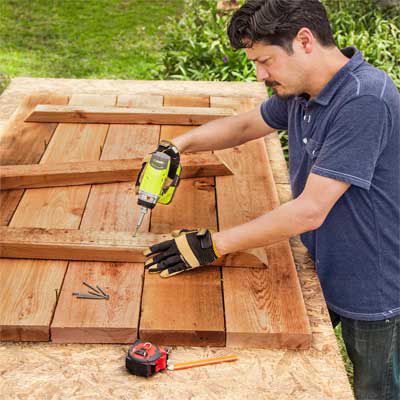
Begin by cutting five 2x8s to a length of 72 inches using a miter saw. Arrange these boards on your work surface with their best sides facing down. Use 16d nails as spacers between the boards to ensure consistent gaps. Next, cut three 2×4 cleats to 31-and-7/8 inches with 45-degree bevels on each end. Mark positions for two of these cleats, inset 12 inches from either end and centered across the width of the tabletop. Apply construction adhesive to the cleats and secure them across the boards using 2-and-1/2-inch deck screws in a zigzag pattern to avoid splitting the wood.
Step 2: Use the Tabletop as a Jig
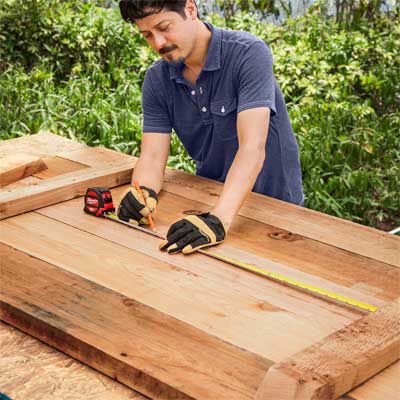
To create a jig for laying out the legs, measure 30 inches (minus the thickness of the top) from the inside edge of one cleat. Make several marks across the width of the tabletop at this measurement. Temporarily attach the third cleat at these marks using two screws. This setup will serve as a precise guide for the next steps, ensuring that the legs are positioned and angled accurately.
Step 3: Cut the Angled Feet To Lay Out the Table Legs
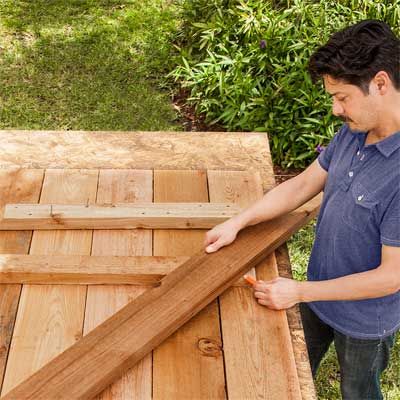
Position a 2×6 diagonally across your jig, ensuring the outside edge overlaps the cleat where the bevel begins and the opposite edge overlaps the bevel on the temporary cleat. Mark each edge of the board where it intersects the cleats. Remove the board and connect these marks. Use one of the resulting lines to set the angle of your miter saw blade. Cut the leg and test its fit in the jig. If accurate, use this piece as a template to mark the other three legs. Remove the temporary cleat, center it between the other two, and fasten it with construction adhesive and 2-and-1/2-inch screws. Double-check the stability of all connections before moving on.
Step 4: Mark the Half-Lap Joint
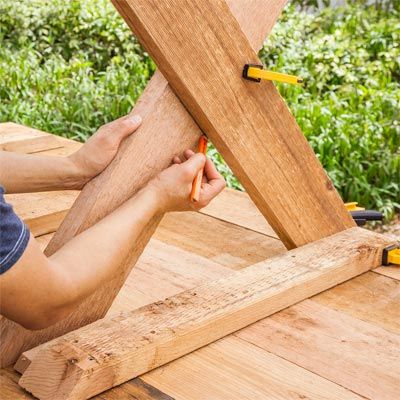
Arrange a pair of legs in an X pattern, standing them up so the mitered ends resting on the table align flush with the cleat’s bevels. Clamp the legs together at their intersection point. Use a piece of scrap wood to fill the gap between the cleat and one leg, then clamp this assembly against the cleat. Carefully mark where each edge of each leg board overlaps the other. This step creates a snug half-lap joint, which helps the overall stability and strength of the table’s leg structure.
Step 5: Cut the Half-Lap Joint and Build the Legs
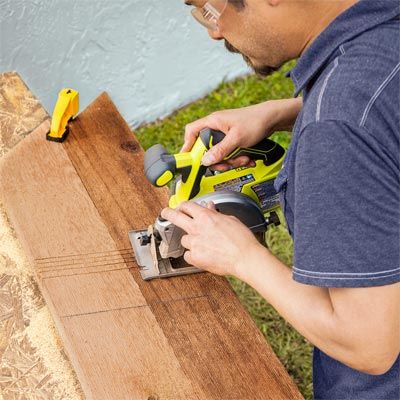
Separate the legs and secure them to your work surface, aligning them to the marks you made in the step above. Set your circular saw blade depth to half the width of the material (7/8 inch for 1-and-3/4-inch rough-sawn cedar). Make a series of crosscuts between the marks you made earlier. This technique, known as “kerfing,” will help you remove the waste material more easily in the next step. Ensure your cuts are even and parallel to achieve a better fit.
Step 6: Clean Out the Cut
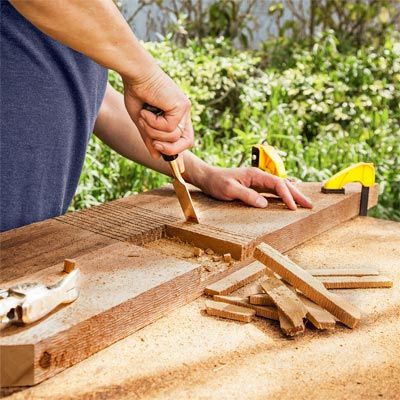
Use a hammer to carefully knock out the wood slivers created by your saw cuts. Then, with a sharp chisel, pare the bottom of the joint smooth on each leg. Remember to keep the flat side of the chisel against the wood for the cleanest results.
Test the fit of your joint. It should be snug but not so tight that it prevents the natural seasonal movement of the wood. Use these two parts as a template to mark the other leg assembly. Apply construction adhesive to half the joint, press the other half in place, and secure the legs together with 1-and-1/4-inch deck screws, placing one in each corner of the joint. Ensure the joint is tight and all screws are fastened to maintain the leg’s integrity.
Step 7: Attach the Legs
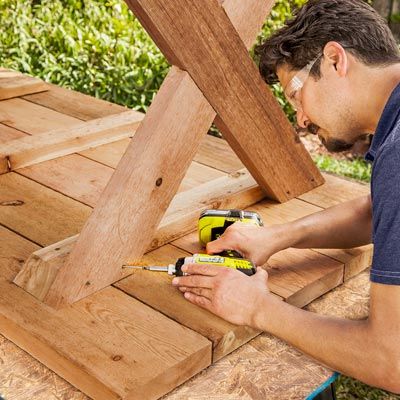
Position one leg assembly on the outside of a cleat and fasten it securely with 4-inch deck screws. Use two screws per leg for maximum stability. Repeat this process for the second pair of legs on the opposite side of the table. Confirm that both leg assemblies are square and level before proceeding to the next step.
Step 8: Find the Angle To Brace the Legs

To determine the correct angle for the braces, place a 2×4 against the center cleat with one end touching both the cleat and the tabletop. Rest the other end alongside the intersection of the legs, and have a helper hold it in place. At the end touching the cleat, use a rafter square to mark a cut line perpendicular to the table surface. Determining the right angle ensures that the braces will fit securely without gaps.
Step 9: Mark the Brace
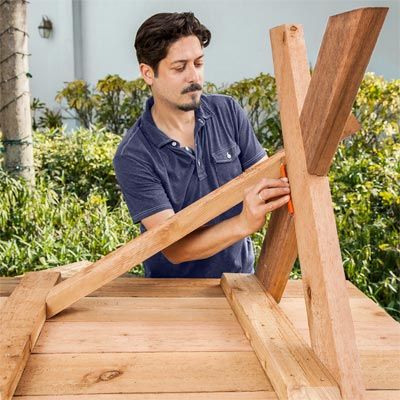
Mark the point where the brace crosses the leg assembly. With both the length and angles of the brace now marked, use these lines to adjust your miter saw and make the cuts on both ends. Test the fit and make small adjustments as needed, aiming for the end against the legs to land roughly in the center of the half-lap joint. Repeat this process for the second brace.
Step 10: Attach the Brace
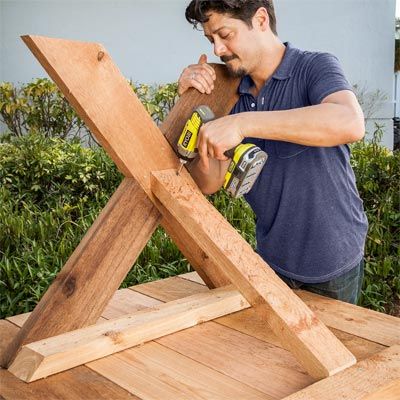
Position the brace between the center cleat and the leg assembly. Secure it to the legs using 2-and-1/2-inch screws. Then, attach the brace to the cleat by driving 2-and-1/2-inch screws through the sides of the brace and into the cleat. This connection adds stability to your picnic table. Repeat this step for the other brace on the opposite side. Make sure the braces are firmly anchored to prevent any wobbling or shaking.
Step 11: Make the Seats and Legs for the Benches
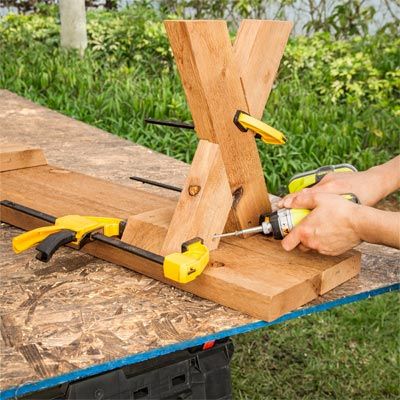
For the benches, follow steps 1 through 3, but use two 2x6s for the seats and 2x4s for the legs. Cut the cleats to the full width of the seat and bevel their ends at 30 degrees. As with the table, use the third cleat to create a jig for laying out the legs. After cutting and assembling the half-lap joints for the legs, clamp the assembly to the cleat and attach it with 4-inch screws. Double-check every connection to ensure the seats will support weight equally and consistently.
Step 12: Make the Seats and Legs for the Benches
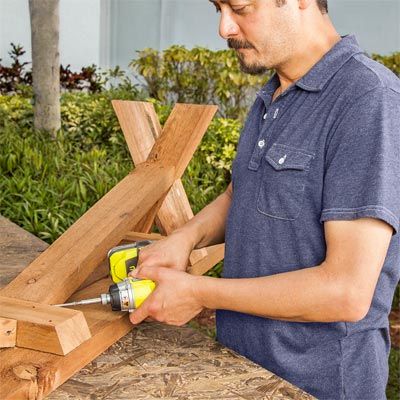
Follow step 4 to determine the angles and lengths needed for the 2×4 braces. Mark, cut, and attach each brace, first securing it to the leg assembly and then to the center cleat. Once complete, flip the bench over and take a moment to admire your handiwork
Our Conclusion
Building a classic picnic table is a rewarding DIY project that results in a great addition to your outdoor space. With careful attention to detail and the right tools, you can create a sturdy table for your summer gatherings. Take your time with the measurements and cuts, especially for the angled components, to ensure a stable and long-lasting picnic table.
Shown: Grill; Weber Original Kettle, $219; homedepot.com
Tools:
 Tape measure
Tape measure Miter saw
Miter saw Pencil
Pencil Caulk gun
Caulk gun Drill/driver
Drill/driver Impact driver
Impact driver Bar clamps
Bar clamps Circular saw
Circular saw Hammer
Hammer Chisel
Chisel Rafter square
Rafter square











